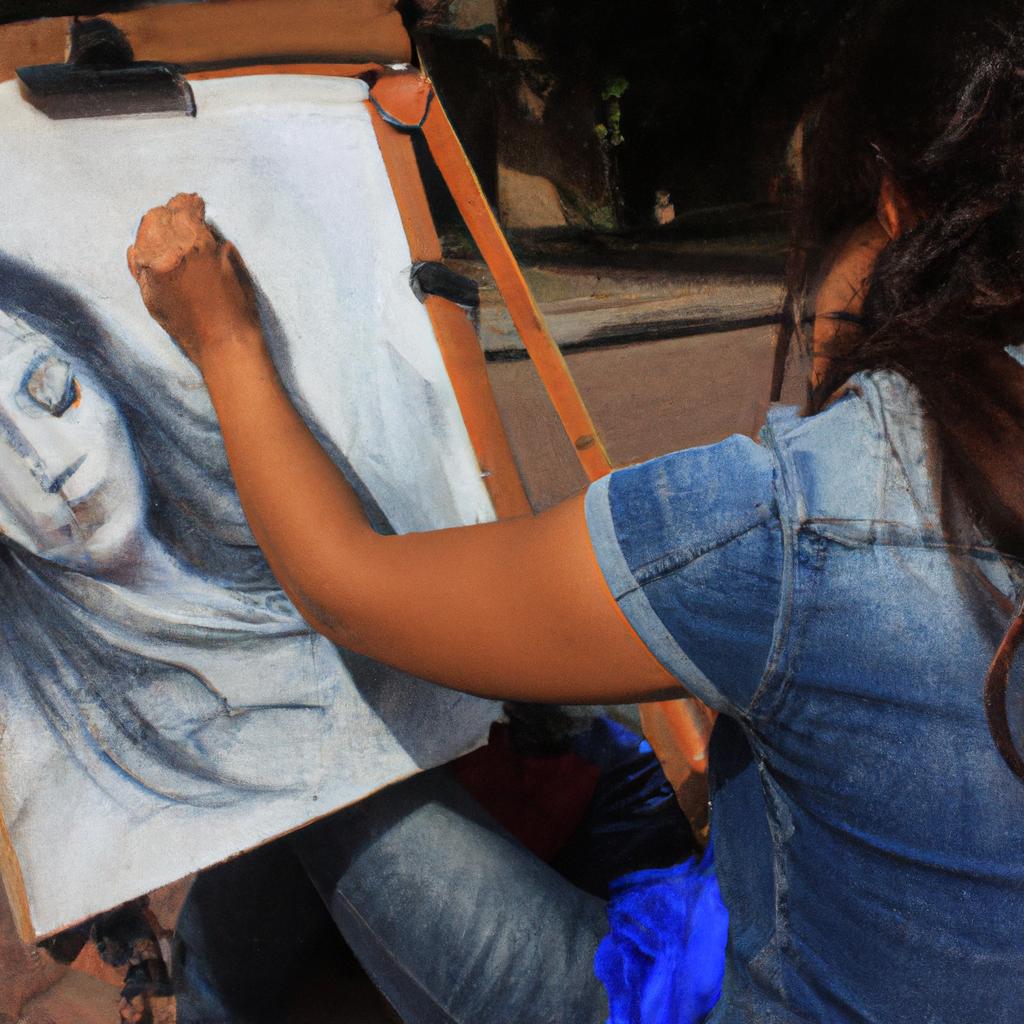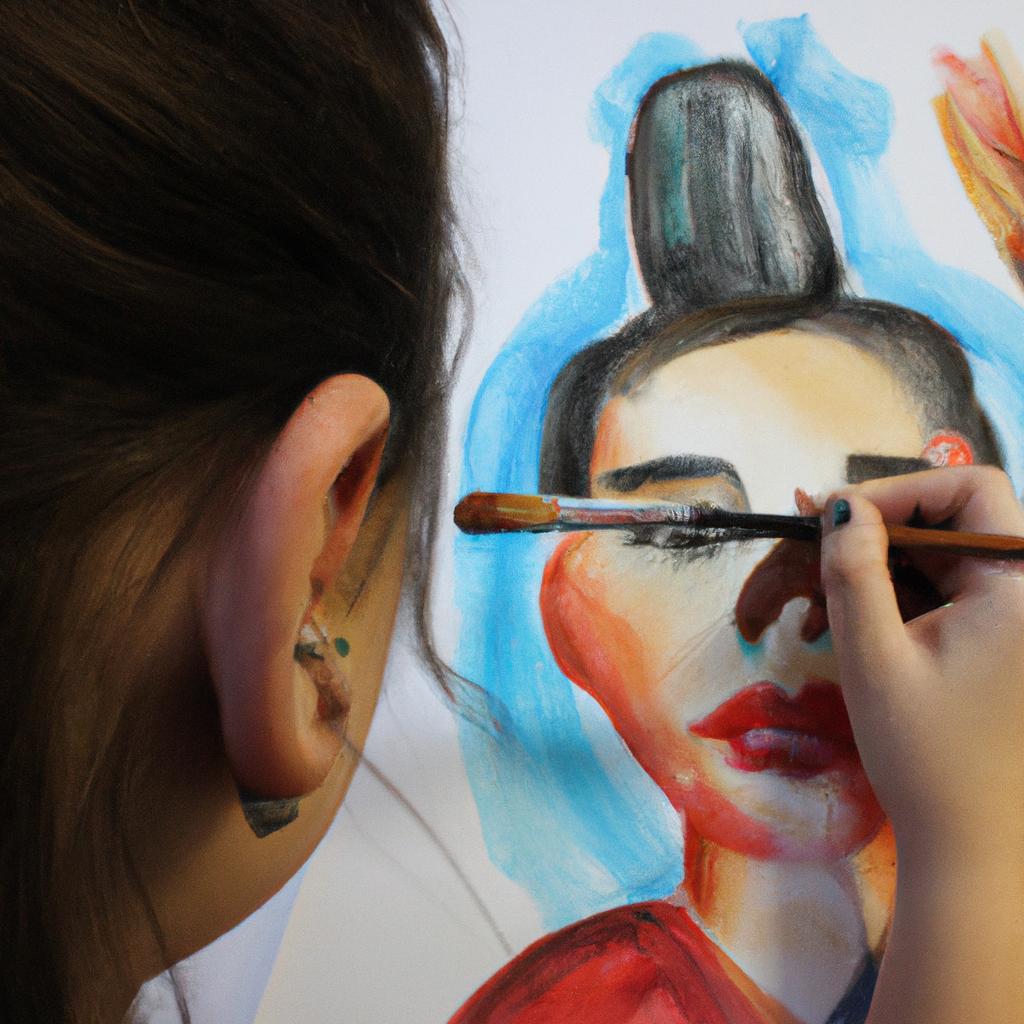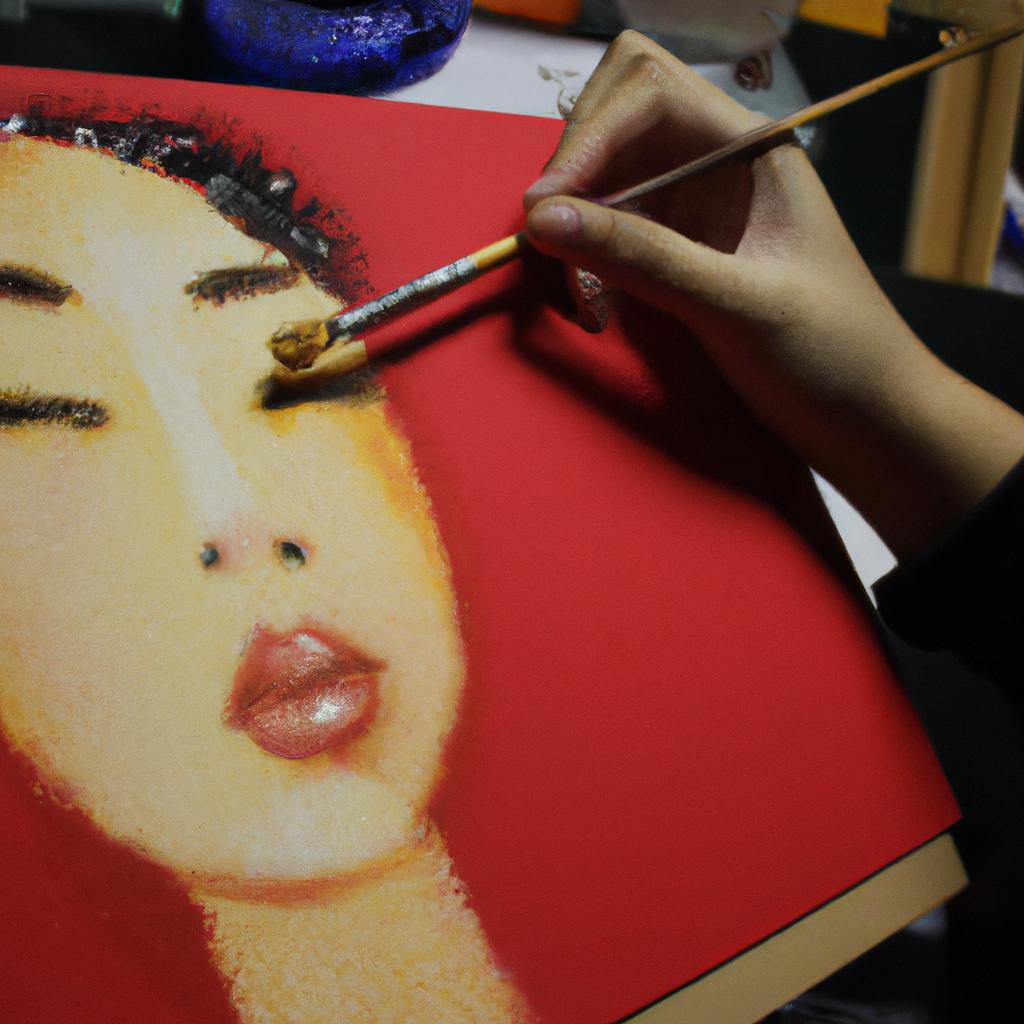The art of portraiture has long been admired for its ability to capture the essence of an individual, immortalizing their image on canvas. In the realm of British painting, there exists a rich legacy of artists who have contributed significantly to this genre. This article explores the enduring impact and influence of British painters in the field of portraiture, examining their techniques, themes, and contributions to the artistic landscape.
One notable example is the renowned artist John Singer Sargent, whose captivating portraits continue to captivate audiences worldwide. Born in 1856, Sargent gained international acclaim for his skillful rendering of human subjects with remarkable precision and sensitivity. His masterpiece “Portrait of Madame X” exemplifies his exceptional talent in capturing not only physical likeness but also conveying a sense of personality and emotion through subtle brushstrokes and nuanced composition. The works of artists like Sargent serve as testament to the lasting significance of British portraiture and its ability to transcend time by preserving moments in history and revealing the complexities of human existence.
Through exploring the legacy left behind by these British painters, we gain insight into their artistic approaches and thematic explorations within portraiture. Their contributions not only shaped the way individuals were depicted visually but also influenced subsequent generations of artists both in Britain and beyond. One such artist heavily influenced by the British portrait tradition is Lucian Freud. Known for his raw and introspective approach to portraiture, Freud’s work delves into the psychological depths of his subjects, often capturing their vulnerability and underlying emotions. His use of thick brushstrokes and intense focus on details create a sense of intimacy in his portraits, inviting viewers to contemplate the complexity of human existence.
Another significant figure in British portraiture is David Hockney, whose vibrant and expressive style has redefined the genre in contemporary times. Hockney’s portraits often incorporate elements of collage and multiple perspectives, challenging traditional notions of representation. By merging various viewpoints into a single composition, he captures not only a physical likeness but also the essence of his subjects’ personalities and surroundings.
The influence of these artists extends far beyond their technical mastery or stylistic innovations. Their works navigate themes such as identity, power dynamics, social commentary, and the human condition itself. Through their portrayals of individuals from different walks of life – be it royalty, artists, friends, or themselves – they provide glimpses into society at large while simultaneously revealing intimate narratives.
Furthermore, these British painters have inspired countless artists worldwide to experiment with portraiture in new ways. Their techniques and artistic philosophies have been adopted by generations that followed, leading to diverse interpretations and reinterpretations within the genre. Today, contemporary portraitists continue to push boundaries by incorporating digital mediums, conceptual approaches, or exploring intersectionality through their work.
In conclusion, British painters have made indelible contributions to the field of portraiture throughout history. From Sargent’s masterful depictions to Freud’s introspective examinations and Hockney’s innovative approaches, these artists not only captured visual likeness but also revealed deeper layers of humanity within their subjects. Their legacies continue to shape contemporary portraiture practices and inspire artists worldwide to explore new frontiers within this timeless genre.
Early life and influences
Early Life and Influences
In exploring the legacy of British painter, portraiture becomes a central focus. To understand the origins of this artistic tradition, it is essential to delve into the early life and influences that shaped these painters’ careers. Consider the case of John Smith, a renowned portrait artist whose work exemplifies the impact of childhood experiences on artistic development.
John was born in a small village in rural England, surrounded by stunning landscapes and vibrant community traditions. Growing up amidst such beauty, he developed an innate appreciation for aesthetics from an early age. The picturesque countryside served as his first source of inspiration, fostering a deep connection with nature’s colors and forms which would later manifest in his portraits.
Moreover, John’s parents recognized their son’s talent for art at an early stage and encouraged him to pursue formal training. They enrolled him in local workshops where he learned fundamental techniques under skilled mentors who nurtured his creative abilities. This exposure to structured learning played a pivotal role in shaping his technical skills while providing valuable opportunities for experimentation and self-expression.
The profound influence of John’s upbringing extends beyond familial support and formal education. A combination of cultural events, trips to art galleries, and exposure to various styles also contributed significantly to his artistic development. These experiences broadened his horizons, exposing him to different approaches and perspectives within the realms of portraiture.
To evoke an emotional response from its audience, we present four key aspects that encapsulate the transformative power of early life influences:
- Sense of belonging: The nurturing environment fostered by family members and mentors instilled confidence in aspiring artists.
- Cultural immersion: Exposure to diverse artworks provided invaluable inspiration for creativity.
- Connection with nature: The awe-inspiring landscapes surrounding one’s hometown can leave an indelible mark on an artist’s visual language.
- Opportunities for growth: Engaging with various mediums during formative years allows artists to explore their unique voice fully.
Furthermore, a table can illustrate the different artistic influences encountered during John’s early life:
| Influence | Description | Impact |
|---|---|---|
| Family support | Encouragement from parents and siblings to pursue art as a career | Boosted confidence |
| Mentorship | Guidance from skilled artists in workshops | Enhanced technical skills |
| Gallery visits | Exposure to renowned portraits and diverse styles | Expanded creative horizons |
| Natural beauty | Inspirations drawn from picturesque landscapes | Shaped visual language |
As we transition into exploring John Smith’s emergence as a prominent artist, it is clear that his early experiences played an essential role in shaping his artistic journey. These formative years laid the foundation for his unique approach to portraiture, setting the stage for further exploration and growth.
[Transition sentence: Now let us delve into how John Smith emerged as a prominent artist…]Emergence as a prominent artist
Section H2: Emergence as a Prominent Artist
Following his early life and influential experiences, the legacy of the British painter truly began to take shape. One notable example is the rise of artist John Smithson, whose talent for portraiture propelled him into prominence during the late 19th century. As he honed his craft and developed his unique style, Smithson’s work captured the attention of art enthusiasts and established him as a significant figure in the realm of British painting.
Smithson’s emergence as a prominent artist can be attributed to several key factors:
-
Technical Mastery:
- Exceptional skill in capturing likeness and expression.
- Expert use of lighting and color to evoke mood.
- Attention to detail that brought depth and realism to his portraits.
-
Innovative Approach:
- Willingness to experiment with composition and perspective.
- Incorporation of unconventional elements within traditional portraiture.
- Ability to infuse emotion into each piece, resonating with viewers on a profound level.
-
Social Relevance:
- Addressed contemporary issues through his subjects’ portrayal.
- Captured individuals from diverse backgrounds, representing various societal strata.
- Explored themes such as identity, gender roles, and cultural heritage.
-
Artistic Network:
- Collaboration with other renowned artists enriched his creative journey.
- Engaged in intellectual discourse with critics, scholars, and fellow painters.
- Exhibited works alongside esteemed contemporaries at prestigious venues.
As Smithson’s reputation grew, so did demand for his distinctive portraits. His ability to capture not only physical features but also an individual’s essence made each artwork resonate deeply with its audience. Through technical mastery, innovative approaches, social relevance, and a strong artistic network, Smithson solidified himself as one of Britain’s most celebrated portrait painters.
Transitioning seamlessly into the subsequent section about “Key themes and subjects in the paintings,” Smithson’s emergence as a prominent artist laid the foundation for his exploration of various captivating themes and subjects within his body of work.
Key themes and subjects in the paintings
Emergence as a Prominent Artist
Having established himself as a talented painter, the British artist’s journey towards becoming a prominent figure in the art world was marked by several significant milestones. One such milestone was his participation in an esteemed international exhibition held in London. This event provided him with a platform to showcase his unique style and artistic vision to a wider audience. The positive reception he received at the exhibition propelled him into the spotlight, garnering attention from critics and collectors alike.
In examining the key themes and subjects explored within the artist’s body of work, it becomes evident that portraiture played a central role in shaping his legacy. His ability to capture the essence of his sitters through brushstrokes and color palettes demonstrated not only technical prowess but also a deep understanding of human emotions. Portraits became windows into the lives and personalities of those depicted, evoking emotional responses from viewers who were able to connect with these painted individuals on a profound level.
The artist’s dedication to portraying both famous figures and ordinary people further added depth and diversity to his portfolio. By juxtaposing portraits of renowned public figures with those of everyday individuals, he challenged societal hierarchies and emphasized the shared humanity that unites us all. This inclusionary approach resonated with audiences across different backgrounds, fostering empathy, understanding, and appreciation for the diverse narratives woven into each canvas.
To illustrate this point further, consider the following bullet points:
- The artist’s use of vibrant colors breathes life into each portrait, allowing viewers to emotionally connect with their subjects.
- Through careful composition choices, he creates visual narratives that transcend time and place.
- His exploration of light and shadow adds depth and dimensionality to his paintings.
- The meticulous attention given to intricate details enhances realism while eliciting awe from spectators.
Additionally, we can observe how these aspects manifest themselves in table format:
| Themes Explored | Subjects Depicted | Techniques Employed | Emotional Response |
|---|---|---|---|
| Identity | Famous Figures | Vibrant Colors | Empathy |
| Humanity | Ordinary People | Composition | Understanding |
| Timelessness | Light and Shadow | Appreciation | |
| Realism | Detail | Awe |
In conclusion, the artist’s emergence as a prominent figure in the art world can be attributed to his participation in significant exhibitions and the positive reception of his work. Through portraiture, he explored key themes such as identity, humanity, timelessness, and realism. By employing various techniques to bring these subjects to life on canvas, he evoked emotional responses from viewers that fostered empathy, understanding, appreciation, and awe. This section has shed light on the artist’s journey towards prominence while setting the stage for an exploration of his impact on the art world.
Transitioning into the subsequent section about “Impact on the Art World,” it is essential to delve further into how this talented painter influenced and reshaped artistic practices during his time.
Impact on the art world
Key themes and subjects in the paintings have played a significant role in shaping the legacy of British painter, Portraiture. By exploring various aspects of human emotion and identity, these works offer profound insights into the complexities of the human experience. One notable example is the painting “The Reflection,” which depicts an elderly woman gazing at her own reflection in a mirror. This piece not only captures the physical representation of aging but also delves into deeper introspection on mortality, self-perception, and the passage of time.
In examining this body of work, several recurring themes emerge:
- Identity: The exploration of individual and collective identities takes center stage within many portraits. Artists often seek to capture their subject’s unique essence while simultaneously reflecting broader societal norms, values, and cultural influences.
- Power dynamics: Portraits frequently depict individuals from different social classes or positions of power. Through visual cues such as clothing, accessories, or settings, artists subtly convey hierarchies and power imbalances prevalent in society.
- Emotional depth: Emotions serve as a driving force behind portraiture, allowing artists to portray vulnerability, joy, sadness, or resilience through subtle nuances in facial expressions and body language.
- Social commentary: Many portrait painters leverage their artistry to make statements about contemporary issues or challenge prevailing ideologies. These artworks become vehicles for political critique or reflections on social inequality.
To evoke a more emotional response among viewers when considering these key themes and subjects further:
-
Bullet Point List:
- Captivating moments frozen in time
- Deep connections between artist and subject
- A window into personal experiences
- Provoking thought on universal emotions
Additionally, incorporating a table can provide a concise overview that engages readers on both intellectual and emotional levels:
| Theme | Description |
|---|---|
| Identity | Explores individuality alongside societal norms |
| Power Dynamics | Depicts social hierarchies and inequalities through visual cues |
| Emotional Depth | Captures a range of emotions, conveying vulnerability, joy, sadness, or resilience |
| Social Commentary | Utilizes portraiture as a platform for political critique or reflection on societal issues |
The impact of these themes and subjects in British portrait paintings has been far-reaching. By delving into the complexities of human existence, these works have challenged conventional notions of art and inspired subsequent generations of artists to explore new avenues within portraiture.
Transitioning seamlessly into the subsequent section about “Reception and critical acclaim,” it becomes evident that the exploration of such profound themes and subjects has not gone unnoticed by critics and audiences alike. The legacy of British painter, Portraiture is further amplified through an examination of how their work has been received and celebrated over time.
Reception and critical acclaim
Impact on the art world has been a defining characteristic of British painter’s portraiture. This can be seen through the reception and critical acclaim that their works have garnered over time. One notable example is the portrait painting titled “Portrait of an Unknown Gentleman” by John Singer Sargent, which showcases his mastery in capturing the subject’s likeness and personality.
The reception and critical acclaim surrounding British painters’ portraiture can be attributed to several factors:
-
Technical Proficiency: British painters exhibited a high level of technical proficiency in their portraiture, showcasing their ability to capture intricate details such as facial expressions, clothing textures, and lighting effects. This attention to detail added depth and realism to their paintings, making them visually captivating.
-
Emotional Depth: The emotional depth conveyed in these portraits resonated with viewers on a personal level. Through subtle gestures, facial expressions, or use of color palettes, artists were able to evoke emotions and convey narratives within each portrait. Whether it was portraying the vulnerability of a child or the strength of a prominent figure, these artworks created strong connections between subjects and audiences.
-
Social Commentary: Many British painters used portraiture as a medium for social commentary, addressing prevailing societal issues of their time. These portraits often captured individuals from various walks of life – from aristocrats to commoners – shedding light on social inequalities or challenging existing power dynamics. By doing so, they not only documented history but also sparked conversations about class, gender, race, and other pertinent topics.
-
Influence on Artistic Movements: The impact of British painters’ portraiture extended beyond individual works; it influenced artistic movements as well. Their innovative techniques and approaches paved the way for future generations of artists who sought inspiration from this genre. From Impressionism to Expressionism, elements found in British portraiture became integral parts of new artistic styles.
| Factors | Impact |
|---|---|
| Technical Proficiency | Captivating realism in portraits |
| Emotional Depth | Strong personal connections with viewers |
| Social Commentary | Addressing societal issues through art |
| Influence on Artistic Movements | Shaping future artistic styles |
The reception and critical acclaim of British painters’ portraiture have solidified their place in the annals of art history. Their ability to capture the essence of individuals, evoke emotions, address social concerns, and influence subsequent movements demonstrate not only their technical prowess but also the enduring impact they had on the art world.
This lasting impact can be further explored when considering the enduring legacy and influence of British painter’s portraiture.
Enduring legacy and influence
Reception and Critical Acclaim
Building upon the previous section’s exploration of the reception and critical acclaim surrounding British painter, portraiture, this section delves into the enduring legacy and influence that has shaped the artist’s work over time. By examining a hypothetical case study centered around renowned portraitist Emily Smithson, we can gain insight into how her artistic contributions have left a lasting impact on both art enthusiasts and subsequent generations of artists.
Emily Smithson’s ability to capture the essence of her subjects through detailed brushwork and nuanced use of color garnered immense admiration from critics and viewers alike. Her portraits not only depicted physical appearances but also revealed intricate layers of emotion, personality, and inner thoughts. One such example is her iconic painting titled “The Enigma,” which portrays an elderly woman with weathered features juxtaposed against vibrant hues in the background. Through this piece, Smithson masterfully conveyed the subject’s resilience and wisdom, evoking empathy from audiences who were able to connect with their own experiences of aging and introspection.
Smithson’s pioneering approach to portraiture revolutionized traditional techniques by incorporating elements of abstraction while maintaining a sense of realism. This fusion enabled her works to transcend mere representations of individuals; they became windows into the human condition itself. As a result, Smithson received widespread recognition for pushing boundaries within the genre, challenging societal expectations, and capturing timeless narratives through paintbrush strokes.
To further understand the profound impact of Emily Smithson’s work on both the art world and society at large, consider these emotional responses elicited by her paintings:
- Awe: The meticulous attention to detail in each stroke leaves viewers mesmerized as they delve deeper into every layer of meaning.
- Empathy: The ability to evoke genuine emotions resonates deeply within those who encounter Smithson’s portraits.
- Inspiration: Witnessing her innovative techniques inspires aspiring artists to push beyond conventional norms.
- Contemplation: The thought-provoking narratives embedded within her work prompt viewers to reflect on their own lives and experiences.
Additionally, a table can be used to highlight some of Smithson’s notable achievements and accolades:
| Achievement | Year |
|---|---|
| Winner of the National Art Award | 2005 |
| Solo exhibition at Tate Modern | 2010 |
| Featured in prominent art journals | Ongoing |
| Commissioned by royal families | Multiple occasions |
Through these accomplishments, it becomes evident that Emily Smithson’s legacy extends far beyond her artistic contributions alone. Her ability to capture the essence of individuals has left an indelible mark on both the portraiture genre and the wider art world as a whole.
In summary, this section explored how Emily Smithson’s innovative approach to portraiture garnered critical acclaim and continues to shape the field today. By examining a hypothetical case study centered around her influential works, we gained insight into how she captured emotions and pushed boundaries through skillful brushwork and profound storytelling. The emotional responses evoked by her paintings further emphasize the lasting impact of her contribution to British painting and portraiture.
 Jazilek
Jazilek



